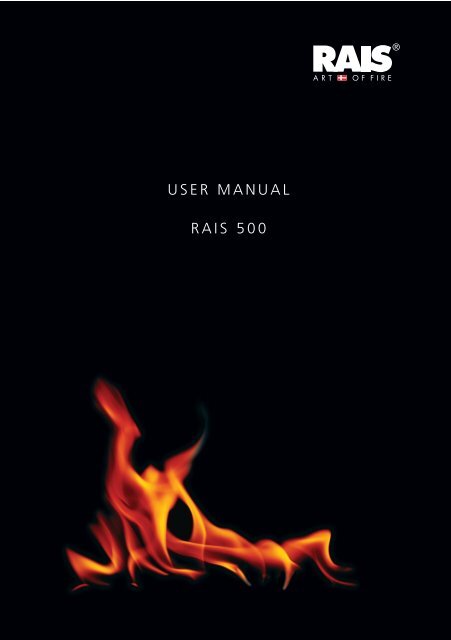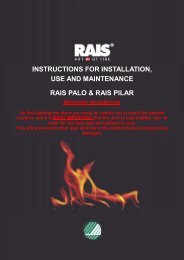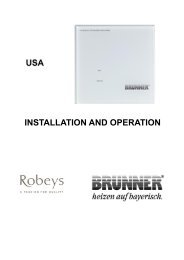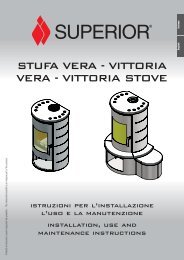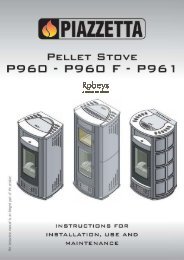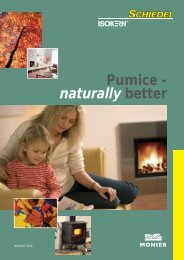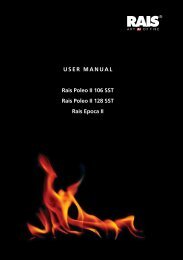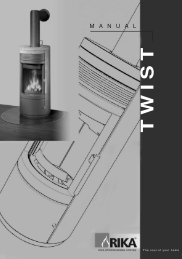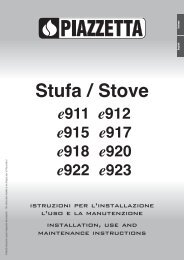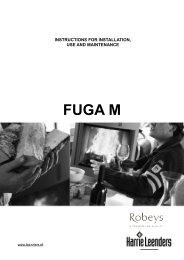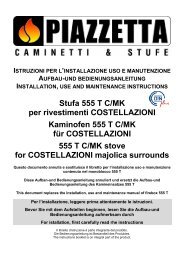USER MANUAL RAIS 500 - Robeys Ltd
USER MANUAL RAIS 500 - Robeys Ltd
USER MANUAL RAIS 500 - Robeys Ltd
Create successful ePaper yourself
Turn your PDF publications into a flip-book with our unique Google optimized e-Paper software.
Dansk <strong>RAIS</strong> - manual til <strong>RAIS</strong> <strong>500</strong><br />
<strong>USER</strong> <strong>MANUAL</strong><br />
<strong>RAIS</strong> <strong>500</strong><br />
PRELEMINARY<br />
1
ENVIRONMENTALLY FRIENDLY FIRE!<br />
5 Eco friendly advices for sensible heating<br />
- Environmentally and moneywise common sense.<br />
1). Effective lighting. Use dry brushwood, kindling or a few cross pages of<br />
newspapers.<br />
Open the air control (plenty of air for the burning), to ensure that the<br />
heated wood is burning rapidly.<br />
2). Use only a little wood at time when burning - this gives the best combus<br />
tion.<br />
Remember plenty of air, each time new firewood is put into the oven.<br />
3). The Air control should be adjusted when the flames blush down, to reduce<br />
the air supply.<br />
4). When only glowing charcoals remain, reduce the air-supply further, so heat<br />
ing demand is just covered. With a lower air supply, charcoal will burn<br />
slower and the heat loss through the chimney is reduced.<br />
5). Use only dry wood - ie wood with a humidity of 15 to 22 percent.<br />
PRELEMINARY<br />
We cannot be held responsible for any misprints.
English <strong>RAIS</strong> - manual for <strong>RAIS</strong> <strong>500</strong><br />
Rais <strong>500</strong><br />
Revision:<br />
Date : 10 July 2012<br />
INTRODUCTION .............................................................................................................4<br />
WARRANTY ...................................................................................................................4<br />
SPECIFICATIONS.............................................................................................................5<br />
INSTALLATIONS INSTRUCTIONS......................................................................................6<br />
CONVECTION ................................................................................................................7<br />
CHIMNEY....................................................................................................................7-8<br />
VENTILATION..................................................................................................................9<br />
CE-LABELLING..............................................................................................................10<br />
AIR-SYSTEM.................................................................................................................11<br />
INSTALLATION ........................................................................................................12-13<br />
INSTALLATION DISTANCE ........................................................................................14-21<br />
FUEL ............................................................................................................................22<br />
REGULATION OF COMBUSTION AIR .............................................................................23<br />
USING THE WOOD BURNING STOVE ...........................................................................24<br />
ADJUSTMENT OF AIR DAMPER ....................................................................................24<br />
CONTROL.....................................................................................................................25<br />
FIRST USAGE................................................................................................................25<br />
LIGHTING AND FUELLING .......................................................................................26-27<br />
CLEANING AND CARE .................................................................................................28<br />
CLEANING OF THE FLUE WAYS.....................................................................................29<br />
INTERRUPTION OF OPERATION ....................................................................................30<br />
ACCESSORIES AND SPARE PARTS............................................................................31-33<br />
PRELEMINARY<br />
3
English <strong>RAIS</strong> - manual for <strong>RAIS</strong> <strong>500</strong><br />
Introduction<br />
Thank you for purchasing a <strong>RAIS</strong> wood burning stove.<br />
These appliances have been approved by HETAS <strong>Ltd</strong> as intermittent operating appliances<br />
for burning wood logs only.<br />
A <strong>RAIS</strong> wood burning stove is more than just a heat source: it also shows that you care<br />
about design and quality in your home.<br />
To make the most of your wood burning stove it is important that you read the manual<br />
thoroughly, before installing and using it.<br />
In the case of warranty coverage, and for general queries regarding your wood burning<br />
stove, it is important that you know the stove’s production number.<br />
We therefore recommend that you note down the number in the table below. The production<br />
number is located in the top of the convex box.<br />
Warranty<br />
Your <strong>RAIS</strong> wood burning stove comes with a 5 year warranty. The warranty, however,<br />
does not cover heat-insulating materials, glass and seals.<br />
Any alterations made to the stove will void the warranty.<br />
Distributor:<br />
Date:<br />
4<br />
PRELEMINARY
English <strong>RAIS</strong> - manual for <strong>RAIS</strong> <strong>500</strong><br />
Specifications<br />
<strong>RAIS</strong> <strong>500</strong><br />
Nominell output (kW): 7,1<br />
Min./Max. output(kW): 4-8<br />
Heating area (m 2 ): ca. 60-120<br />
Stove’s width/depth/height (mm): 708-550-474<br />
Combustion champer’s width/depth/height (mm): 556-306-295<br />
Recommended amount of wood when fuelling (kg):<br />
(Distributed on 2-3 logs of wood approx. 25 cm)<br />
Min. uptake (Pascal): -12<br />
Weight (kg): 110<br />
Efficiency (%): 80<br />
Particles after NS3058/3059 (g/kg): 1,8<br />
Dust measured according to Din+(mg/Nm³): 3<br />
Smoke gas mass flow (g/s): 5,7<br />
Smoke gas temperature (°C)<br />
with Nominal output<br />
Intermittent operation:<br />
PRELEMINARY<br />
1,8<br />
292<br />
Fuelling should be undertaken<br />
within 3 hours.<br />
5
English <strong>RAIS</strong> - manual for <strong>RAIS</strong> <strong>500</strong><br />
Installation instructions<br />
The following pages give instructions for the safe and proper installation of this heating<br />
appliance in the UK. These instructions cover the basic principles of installation, although<br />
detail may need slight modification to suit particular local site conditions. In all cases the<br />
installation must comply with current UK Building Regulations, Local Authority Byelaws<br />
and other specifications or regulations as they affect the installation of the stove. Please<br />
note that it is a legal requirement under England and Wales Building Regulations that<br />
the installation of the stove is either carried out under Local Authority Building Control<br />
approval or is installed by a Competent Person registered with a Government approved<br />
Competent Persons Scheme. HETAS <strong>Ltd</strong> operate such a Scheme and a listing of their Registered<br />
Competent Persons can be found on their website at www.hetas.co.uk.<br />
It should be noted that the current Building Regulations requirements are given in Approved<br />
Document J. These requirements may also be met by adopting the relevant recommendations<br />
given in British Standards BS 8303, BS 6461 and BS 7566.<br />
WARNING: Health and Safety Advice Notice<br />
The installation of this heating appliance is governed by the Health and Safety at Work<br />
Act 1974. It is the responsibility of the installer to ensure that all requirements of this Act<br />
are met during the installation works. Attention is drawn in particular to the following:<br />
Handling:<br />
The appliance is a heavy item and adequate facilities must be available for<br />
loading, unloading and site handling.<br />
Fire Cement: Some types of fire cement are caustic and should not be allowed to come<br />
into contact with the skin. Protective gloves should be worn when handling<br />
fire cement. In case of contact with the skin wash immediately with plenty<br />
of water.<br />
Asbestos:<br />
Metal Parts:<br />
This stove contains no asbestos. If there is a possibility of disturbing any<br />
asbestos in the course of installation then please seek specialist guidance<br />
and use appropriate protective equipment.<br />
When installing or servicing this stove care should be taken to avoid the<br />
possibility of personal injury.<br />
Important Warning –Preparatory Work and Safety Checks:<br />
• This stove must not be installed into a chimney that serves any other heating appliance.<br />
• There must not be an extractor fan fitted in the same room as the stove as this can<br />
cause the stove to emit fumes into the room.<br />
• If this appliance is installed into an existing chimney, the chimney must first be swept<br />
and examined for soundness and suitability before the appliance is installed (see also<br />
section headed “Chimney”).<br />
6<br />
PRELEMINARY
English <strong>RAIS</strong> - manual for <strong>RAIS</strong> <strong>500</strong><br />
Convection<br />
<strong>RAIS</strong> stoves are convection stoves. This means that the stove’s back and side panels are<br />
not over-heated. Convection means that there is a circulation of air, which ensures that<br />
the heat is distributed more evenly throughout the entire room. The cold air is sucked in<br />
at the base of the stove up through the convection channel, which runs along the stove’s<br />
combustion chamber. The heated air pours out at the top of the stove, which ensures a<br />
circulation of warm air throughout the room.<br />
The stoves are equipped with “cold” door handles – <strong>RAIS</strong> special feature – which means<br />
you could almost do away with gloves. Be aware, however, that all exterior surfaces become<br />
hot during use - so take extreme care.<br />
Chimney<br />
The chimney is the driving force which makes the stove function. In order for the stove to<br />
perform satisfactorily the chimney height must be sufficient to ensure the correct draught<br />
of 14 to 18 Pa so as to clear the products of combustion and prevent problems of smoke<br />
emanating into the room when firing.<br />
NOTE: A chimney height of not less than 4.5 metres measured vertically from the outlet<br />
of the stove to the top of the chimney should be satisfactory. Alternatively the calculation<br />
procedure given in BS 5854:1980 may be used as the basis for deciding whether a<br />
particular chimney design will provide sufficient draught.<br />
The outlet from the chimney should be above the roof of the building in accordance with<br />
the provisions of Building Regulations Approved Document J.<br />
If installation is into an existing chimney then it must be sound and have no cracks or<br />
other faults which might allow fumes into the house. Older properties, especially, may<br />
have chimney faults or the cross section may be too large i.e. more than 230 mm x 230<br />
mm. Remedial action should be taken, if required, seeking expert advice, if necessary. If it<br />
is found necessary to line the chimney then a flue liner suitable for solid fuel must be used<br />
in accordance with Building Regulations Approved Document J.<br />
Any existing chimney must be clear of obstruction and have been swept clean immediately<br />
before installation of the stove. If the stove is fitted in place of an open fire then the<br />
chimney should be swept one month after installation to clear any soot falls which may<br />
have occurred due to the difference in combustion between the stove and the open fire.<br />
If there is no existing chimney then either a prefabricated block chimney in accordance<br />
with Building Regulations Approved Document J or a twin walled insulated stainless steel<br />
flue to BS 4543 can be used. These chimneys must be fitted in accordance with the manufacturer’s<br />
instructions and Building Regulations.<br />
PRELEMINARY<br />
7
English <strong>RAIS</strong> - manual for <strong>RAIS</strong> <strong>500</strong><br />
A single wall metal fluepipe is suitable for connecting the stove to the chimney but is not<br />
suitable for using for the complete chimney. The chimney and connecting fluepipe must<br />
have a minimum diameter of 150 mm and its dimension should be not less than the size<br />
of the outlet socket of the stove which is 150 mm in diameter. Any bend in the chimney<br />
or connecting fluepipe should not exceed 45°. 90°bends should not be used.<br />
Combustible material should not be located where the heat dissipating through the walls<br />
of fireplaces or flues could ignite it. Therefore when installing the stove in the presence<br />
of combustible materials due account must be taken of the guidance on the separation<br />
of combustible material given in Building Regulations Approved Document J and also in<br />
these stove instructions.<br />
If it is found that there is excessive draught in the chimney then either an adjustable flue<br />
damper or alternatively a draught stabiliser should be fitted. The adjustable flue damper<br />
should not close off the flue entirely but should in its closed position leave a minimum<br />
continuous opening free area of at least 20 % of the total cross sectional area of the flue<br />
or fluepipe.<br />
Adequate provision e.g. easily accessible soot door or doors must be provided for sweeping<br />
the chimney and connecting fluepipe.<br />
You should also familiarise yourself with the draught conditions for chimneys with 2 flues.<br />
The flue outlet spigot is 150 mm in diameter.<br />
For strong draughts, the chimney or flue should be fitted with a draught stabiliser. In<br />
which case, it is important to ensure that there is a free flow-through area of minimum<br />
20 cm² when the regulating gate is shut. Otherwise, the fuel energy may not be used<br />
optimally. If, at any time, you are unsure about the condition of the chimney, you should<br />
contact a chimney sweep.<br />
Remember that access to the access door should be kept clear.<br />
8<br />
PRELEMINARY
English <strong>RAIS</strong> - manual for <strong>RAIS</strong> <strong>500</strong><br />
Ventilation - make the best possible use of the inserts.<br />
The stove is equipped with four convection air outlet, which may be connected with suitable<br />
air ducts to other rooms.<br />
PRELEMINARY<br />
9
English <strong>RAIS</strong> - manual for <strong>RAIS</strong> <strong>500</strong><br />
10<br />
Produced at:<br />
<strong>RAIS</strong> A/S, Industrivej 20, 9900 Frederikshavn, Danmark<br />
EN 13229:2001+A2:2004<br />
Raumheizer für feste Brennstoffe<br />
12<br />
EC.NO: 511<br />
Appliance fired by wood<br />
Poêle pour combustibles solides<br />
<strong>RAIS</strong> <strong>500</strong> 1G / 1SG / 2G / 2SG / 3G / 3SG<br />
Anordningen må kun installeres i forbindelse med ubrændbart materiale.<br />
AFSTAND TIL BRÆNDBART, BAGVÆG<br />
ABSTAND ZU BRENNBAREN BAUTEILEN, HINTEN<br />
DISTANCE TO COMBUSTIBLE BACK WALL<br />
DIST. ENTRE COMPOSANTS COMBUSTIBLES, ARRIÈRE<br />
AFSTAND TIL BRÆNDBART, SIDEVÆG<br />
ABSTAND ZU BRENNBAREN BAUTEILEN, SEITE<br />
DISTANCE TO COMBUSTIBLE SIDE WALL<br />
DISTANCE ENTRE COMPOSANTS COMBUSTIBLES, COTÉ<br />
AFSTAND TIL BRÆNDBART, MØBLERING<br />
DK:800 mm/SE BRUGERVEJLEDNING<br />
ABSTAND VORNE ZU BRENNBAREN MÖBELN<br />
DE:800 mm/SIEHE BEDIENUNGSANLEITUNG<br />
DISTANCE TO FURNITURE AT THE FRONT<br />
UK:800 mm/SEE <strong>USER</strong> <strong>MANUAL</strong><br />
DISTANCE ENTRE COMPOSANTS COMBUSTIBLES, DEVANT FR:800 mm/CONSULTEZ LE GUIDE DE L'UTILISATEUR<br />
CO EMISSION<br />
CO EMISSION IN DEN VERBRENNUNGSPRODUKTEN<br />
EMISSION OF CO IN COMBUSTION PRODUCTS<br />
EMISSION CO DANS LES PRODUITS COMBUSTIBLES<br />
STØV / STAUB /<br />
DUST / POUSSIÈRES:<br />
RØGGASTEMPERATUR / ABGASTEMPERATUR /<br />
FLUE GAS TEMPERATURE / TEMPÉRATURE DES GAZ DE FUMÉE:<br />
NOMINEL EFFEKT / HEIZLEISTUNG /<br />
THERMAL OUTPUT / PUISSANCE CALORIFIQUE:<br />
VIRKNINGSGRAD / ENERGIEEFFIZIENZ /<br />
ENERGY EFFIENCY /EFFICACITÉ ÉNERGÉTIQUE:<br />
DK: Brændsel (Brug kun anbefalede brændsler) Følg instrukserne i brugermanualen.<br />
Anordningen er egnet til røggassamleledning og intervalfyring.<br />
DE: Hinweis: Lesen und befolgen Sie die Bedienungsanleitung. Für mehrfach belegten<br />
Schornstein zugelassene Zeitbrandfeuerstätte. Nur empfohlene Brennstoffe einsetzen.<br />
UK: Fuel types (only recommended) Follow the installation and<br />
operating instruction manual. Intermittent operation.<br />
F: Remarque: Veillez lire et observer les instructions du mode d'emploi.<br />
Foyer à durèede combustion limitèe, homologué pour cheminée à<br />
connexions multiples. Utiliser seulement les combustibles recommandés.<br />
Hergestellt für /Produced for:<br />
ATTIKA FEUER AG, Brunnmatt 16, CH-6330 Cham / <strong>RAIS</strong> A/S, Industrivej 20, DK-9900 Frederikshavn<br />
Certification<br />
110-xxxx/TGxxxxx<br />
15a B-VG<br />
VKF-NR:<br />
XXXXX<br />
Bauart: 2<br />
DIBt: x-xx-xx-xx<br />
DK: SE BRUGERVEJLEDNING<br />
DE: SIEHE BEDIENUNGSANLEITUNG<br />
UK: SEE <strong>USER</strong> <strong>MANUAL</strong><br />
FR: CONSULTEZ LE GUIDE DE L'UTILISATEUR<br />
DK: SE BRUGERVEJLEDNING<br />
DE: SIEHE BEDIENUNGSANLEITUNG<br />
UK: SEE <strong>USER</strong> <strong>MANUAL</strong><br />
FR: CONSULTEZ LE GUIDE DE L'UTILISATEUR<br />
DK: 0,06%<br />
DE: 0,06% / 733 mg/nm3<br />
UK: 0,06%<br />
FR: 0,06%<br />
DK: 3 mg/Nm3 / DE: 3 mg/Nm3<br />
UK: 3 mg/Nm3 / FR: 3 mg/Nm3<br />
DK: 292°C / DE: 292°C<br />
UK: 292°C / FR: 292°C<br />
DK: 7,1 kW / DE: 7,1 kW<br />
UK: 7.1 kW / FR: 7,1 kW<br />
DK: 80% / DE: 80%<br />
UK: 80% / FR: 80%<br />
DK: BRÆNDE<br />
DE: HOLZ<br />
UK: WOOD<br />
FR: BOIS<br />
<br />
xxx / xx<br />
Krav på anslutande rökkanal: 350°C<br />
Besigtningsorgan:<br />
DTI<br />
Tilverkningsnummer: XXX<br />
<br />
<br />
<br />
<br />
<br />
<br />
PRELEMINARY
English <strong>RAIS</strong> - manual for <strong>RAIS</strong> <strong>500</strong><br />
Air-system<br />
When mounting the Air system ensures that the air control system get fresh air from<br />
outside.ra.<br />
To ensure that Air system works, you have to build in items of ensuring that heres can be<br />
no vacuum in the home.<br />
Air connection can be mounten behind or under the oven.<br />
Note!!<br />
Be aware if the Airbox mounted at the bottom increased the total height.<br />
eg. Flex hose<br />
PRELEMINARY<br />
11
English <strong>RAIS</strong> - manual for <strong>RAIS</strong> <strong>500</strong><br />
Installation<br />
It is prohibited to carry out unauthorised alterations to the stove.<br />
There must be plenty of fresh air in the room where the stove is being installed, in order<br />
to ensure proper combustion. Note that any mechanical exhaust ventilation - e.g. an<br />
extraction hood - may reduce the air supply. Any air grates must be placed in such a manner,<br />
that the air supply is not blocked.<br />
The stove is equipped with four convection air outlets, which may be connected with suitable<br />
air ducts to other rooms.<br />
Building Regulations Approved document J gives specific guidance on the required<br />
permanent ventilation into the room for combustion air of solid fuel appliances.<br />
The floor structure must be able to carry the weight of the wood burning stove, as well as<br />
the weight of a chimney, if necessary.<br />
When you choose where to set up your <strong>RAIS</strong> wood burning stove, you should consider<br />
the heat distribution to the other rooms. This will enable you to get the best use out of<br />
your stove. The stove should be set up at a safe distance from inflammable materials. See<br />
the manufacturer’s plate on the wood burning stove.<br />
Installation of stove:<br />
NOTE: Decision to be taken concerning the placement of the inlets and outlets of the<br />
convection system. The area requirements for convection holes to be kept.<br />
Miscolouring of the wall above the doors and the convection air outlets may<br />
occur due to raising hot air.<br />
<strong>RAIS</strong> cannot take responsibility for building in or consequential damage.<br />
The stove to be inspected for defects at receipt.<br />
12<br />
PRELEMINARY
English <strong>RAIS</strong> - manual for <strong>RAIS</strong> <strong>500</strong><br />
Lift the stove from the pallet to the place of installation on a suitable floor protection. The<br />
stove can be mounted with rack and adjustable leg (buy accessories at your local <strong>RAIS</strong><br />
dealer)<br />
The stove is aligned by adjusting screws, so the lower edge of the glass door is in horizontal<br />
position and the surface of the door is vertical when the door is closed.<br />
Remove the front plate and door from the stove. Be careful not to damage the glass on<br />
the door. Protect the painted stove body against spray of cement and paint.<br />
Install the uninsolated flue pipe on the flue outlet inside the convection box.<br />
It is important that there are no leakage between the flue pipe and the stove. It is recommended<br />
to seal the connection by suitable gasket or compound.<br />
Install the insulated flue pipe and connect to chimney.<br />
Install fresh air inlet connection to the pipe stub if such is to be installed (if chosen).<br />
If pipes are intended installed on the outlets of the convection system this is recommended<br />
before building further.<br />
The stove is now ready for building into either panels or brick wall.<br />
After establishing the wall and eventually painted, the fronts and covers are mounted<br />
again. Remove all protective plastic and tape.<br />
It is possible to deliver front panels in special measures if needed together with the stove.<br />
Contact your local <strong>RAIS</strong> dealer.<br />
NB!!<br />
<strong>RAIS</strong> A/S recommends that the stove installed by a licensed/qualified<br />
electrician.<br />
Ask your deaker for details.<br />
PRELEMINARY<br />
13
English <strong>RAIS</strong> - manual for <strong>RAIS</strong> <strong>500</strong><br />
Mounting distance - (height x width) 474 x 732<br />
A wood burner insert should never fit tightly. Steel expands when heated.<br />
Panel wall<br />
Brick wall<br />
14<br />
PRELEMINARY
English <strong>RAIS</strong> - manual for <strong>RAIS</strong> <strong>500</strong><br />
Mounting distance 2G - (height x width) 474 x 708<br />
A wood burner insert should never fit tightly. Steel expands when heated.<br />
Panel wall<br />
Brick wall<br />
PRELEMINARY<br />
15
English <strong>RAIS</strong> - manual for <strong>RAIS</strong> <strong>500</strong><br />
Mounting distance 3G - (height x width) 474 x 708<br />
A wood burner insert should never fit tightly. Steel expands when heated.<br />
Panel wall<br />
Brick wall<br />
16<br />
PRELEMINARY
English <strong>RAIS</strong> - manual for <strong>RAIS</strong> <strong>500</strong><br />
Mounting distance for panelled wall - non-combustible material<br />
Recommended min convection<br />
area above the stove : 800 cm²<br />
(may be distributed)<br />
Recommended min convection<br />
area below the stove : <strong>500</strong> cm²<br />
(may be distributed)<br />
Min. 100 mm<br />
Min. 100 mm<br />
Distance to combustible<br />
material min. 250 mm<br />
Distance to combustible material<br />
min. 150 mm (e.g. door frame)<br />
PRELEMINARY<br />
Distance to combustible material<br />
min. 200 mm (e.g. side wall)<br />
To guide the hot air out of the<br />
gratings, we recommends to<br />
install a non-flammable plate<br />
just above the holes.<br />
NB!!<br />
Insulated chimney down to the<br />
smoke connector (not included)<br />
Clearance<br />
min. 800 mm<br />
It is recommended to knock out the 3<br />
areas - prepared for heat transfer - out.<br />
Min. 300 mm<br />
Min. 100 mm<br />
Distance<br />
min. 400 mm<br />
Distance to furniture<br />
min. 900 mm<br />
17
English <strong>RAIS</strong> - manual for <strong>RAIS</strong> <strong>500</strong><br />
Mounting distance for brick wall / firewall<br />
18<br />
Recommended min convection<br />
area above the stove : 800 cm²<br />
(may be distributed)<br />
Recommended min convection<br />
area below the stove : <strong>500</strong> cm²<br />
(may be distributed)<br />
Distance to non-combustible material 0 mm<br />
(10 mm is recommended)<br />
Distance to combustible material<br />
min. 200 mm (e.g. side wall)<br />
Distance to combustible<br />
material min. 250 mm<br />
It is recommended to knock out the 3<br />
areas - prepared for heat transfer - out.<br />
Min. 300 mm<br />
To guide the hot air out of the<br />
gratings, we recommends to<br />
install a non-flammable plate<br />
just above the holes.<br />
Min. 100 mm<br />
Clearance<br />
min. 800 mm<br />
Distance<br />
min. 400 mm<br />
Distance to furniture<br />
min. 900 mm<br />
PRELEMINARY
English <strong>RAIS</strong> - manual for <strong>RAIS</strong> <strong>500</strong><br />
Mounting distance - 2G / 3G<br />
non-combustible material:<br />
Distance to<br />
combustible<br />
material<br />
min. 200 mm<br />
Min. 300 mm<br />
Recommended min convection<br />
area above the stove : 800 cm²<br />
(may be distributed)<br />
NB!!<br />
Insulated chimney down<br />
to the smoke connector<br />
(not included)<br />
Distance to combustible<br />
material min. 250 mm<br />
Recommended min convection<br />
area below the stove : <strong>500</strong> cm²<br />
(may be distributed)<br />
Min. 100 mm<br />
Distance to combustible<br />
material min. 200 mm<br />
Clearance<br />
min. 800 mm<br />
It is recommended to knock out the 3<br />
areas - prepared for heat transfer - out.<br />
To guide the hot air out of the<br />
gratings, we recommends to<br />
install a non-flammable plate<br />
just above the holes.<br />
Distance<br />
min. 400 mm<br />
Distance to furniture<br />
min. 900 mm<br />
PRELEMINARY<br />
19
English <strong>RAIS</strong> - manual for <strong>RAIS</strong> <strong>500</strong><br />
Mounting distance - 2G / 3G<br />
brick:<br />
20<br />
If not generating enough convection, there may be damage to the brick walls.<br />
Distance to combustible<br />
material min. 200 mm<br />
Min. 300 mm<br />
Recommended min convection<br />
area above the stove : 800 cm²<br />
(may be distributed)<br />
Distance to combustible<br />
material min. 250 mm<br />
Recommended min convection<br />
area below the stove : <strong>500</strong> cm²<br />
(may be distributed)<br />
Distance to<br />
combustible<br />
material<br />
min. 200 mm<br />
To guide the hot air out of the<br />
gratings, we recommends to<br />
install a non-flammable plate<br />
just above the holes.<br />
Min. 100 mm<br />
It is recommended to knock out the 3<br />
areas - prepared for heat transfer - out.<br />
Clearance<br />
min. 800 mm<br />
Distance<br />
min. 400 mm<br />
Distance to furniture<br />
min. 900 mm<br />
PRELEMINARY
English <strong>RAIS</strong> - manual for <strong>RAIS</strong> <strong>500</strong><br />
Installation distance in case of combustible wall<br />
To find out whether the wall next to where the stove is going to be installed is flammable,<br />
you should contact your building contractor or the local building authorities.<br />
The hearth should be able to accommodate the weight of the stove. The chimney must<br />
be independently supported by wall brackets or a ceiling support plate. The weight of the<br />
stove is indicated in the brochure.<br />
The stove should always be installed on a non-combustible hearth of a size and construction<br />
that is in accordance with the provisions of the current UK Building Regulations Approved<br />
Document J.<br />
If the stove is to be installed on a wooden floor, it must be covered with a noncombustible<br />
material at least 12mm thick, in accordance with UK Building Regulations Approved Document<br />
J, to a distance of 300 mm in front of the stove and 150 mm to each side measuring<br />
from the door of the combustion chamber.<br />
The clearance distances to combustible material beneath, surrounding or upon the hearth<br />
and walls adjacent to the hearth should comply with the guidance on the separation of<br />
combustible material given in UK Building Regulations Approved Document J and also in<br />
these stove instructions.<br />
For the Installer<br />
Finally before firing the stove for the first time a check should be made to ensure that the<br />
assembly and stove installation has been satisfactory and that there are no leaks in any<br />
seals in the appliance and appliance connections to the chimney.<br />
Ensure that the appliance and chimney flue are functioning correctly before finally handing<br />
over to the user. If necessary read the later parts of this manual for guidance on care<br />
required when first lighting.<br />
Inform the user that the appliance has been commissioned and ready to use and give<br />
instruction on the safe operation of the stove.<br />
These Instructions must be left with the user and the user should be instructed to keep<br />
them in a safe place.<br />
PRELEMINARY<br />
21
English <strong>RAIS</strong> - manual for <strong>RAIS</strong> <strong>500</strong><br />
Operating instructions<br />
Please note that HETAS <strong>Ltd</strong> Appliance Approval only covers the use of dry seasoned<br />
wood logs on this appliance. HETAS <strong>Ltd</strong> Approval does not cover the use<br />
of other fuels either alone or mixed with the wood logs, nor does it cover instructions<br />
for the use of other fuels.<br />
Fuel<br />
The stove is designed and approved in accordance with EN 13240 and NS 3058 for stoking<br />
split, dried firewood. The firewood must have a water content of 15-22% and its max.<br />
length should be the length of the combustion chamber minus 50-60 mm.<br />
Stoking with wet firewood causes both soot, environmental pollution and bad fuel<br />
economy. Freshly cut wood contains approx. 50-70% water and is thoroughly unsuitable<br />
for stoking. Count min. 1 year of storage time for newly cut wood before using.<br />
Wood with a diameter of more than 100 mm should be split. Regardless of wood size, it<br />
should always have at least one surface area free of bark.<br />
We do not recommend stoking with painted, laminated or impregnated wood, wood with<br />
a synthetic surface, painted refuse wood, chipboard, plywood, domestic waste, paper briquettes<br />
and pit coal, as this will produce malodorous smoke, which could be poisonous.<br />
When firing with the above-mentioned items and amounts larger than those recommended,<br />
the stove is subjected to a larger amount of heat, which results in a higher chimney<br />
temperature and lower efficiency. This can result in the stove and chimney becoming damaged<br />
and would void the warranty.<br />
The calorific value of the firewood is closely connected to the moisture level of the<br />
firewood. Moist firewood has a low heat value. The more water the wood contains, the<br />
more energy it takes for this water to vaporise, resulting in this energy being lost.<br />
ONLY USE RECOMMENDED FUELS<br />
The following table shows the calorific value of different types of wood, which have been<br />
stored for 2 years, and which have a residual moisture of 15-17%.<br />
Wood Kg dry wood pr. m 3 compared to beech/oak<br />
Hornbeam 640 110%<br />
Beech and oak 580 100%<br />
Ash 570 98%<br />
Maple 540 93%<br />
Birch 510 88%<br />
Mountain pine 480 83%<br />
Fir 390 67%<br />
Poplar 380 65%<br />
PRELEMINARY<br />
1 kg of wood yields the same heat energy irrespective of wood type. 1 kg beech merely<br />
takes up less space than 1 kg of fir.<br />
22
English <strong>RAIS</strong> - manual for <strong>RAIS</strong> <strong>500</strong><br />
Drying and storage<br />
Drying wood takes time: proper air drying takes approx. 2 years.<br />
Here are some tips:<br />
Store the wood sawn, split and stacked in an airy, sunny place, which is protected against<br />
rain (the south side of the house is particularly suitable).<br />
Store the firewood stacks at a hand’s breadth apart, as this ensures that the air flowing<br />
through takes the moisture with it. Avoid covering the firewood stacks with plastic, as<br />
this prevents the moisture from escaping. It is a good idea to bring the firewood into the<br />
house 2-3 days before you need it.<br />
Regulating the combustion air<br />
All <strong>RAIS</strong> stoves are equipped with a one-handed operating lever for regulating the damper.<br />
The stove-specific regulating mechanisms can be seen on the diagrams.<br />
Primary air is the combustion air added to the primary combustion zone, i.e. the bed of<br />
glowing embers. This air, which is cold, is only used in the lighting stage.<br />
Secondary air is the air which is added in the gas combustion zone, i.e. air which contributes<br />
to the combustion of the pyrolysis gasses (preheated air, which is used for the<br />
cleaner glass system and combustion). This air is sucked through the damper under the<br />
combustion chamber and is pre-heated through the side channels and then emitted as<br />
hot scavenging air onto the glass. The hot air rinses the glass and keeps it soot-free.<br />
The tertiary channel, which can be seen at the the top of the combustion chamber towards<br />
the back, serves to combust the final gas residues.<br />
By setting the interval between position 1 and 2, the energy content in the firewood is<br />
used optimally, as there is oxygen for combustion and for the burning of the pyrolysis<br />
gasses. When the flames are a clear yellow the damper has been set correctly. Finding the<br />
correct position comes with time after you have used for stove for a while.<br />
It is not recommended that you turn it down completely. A mistake commonly made is<br />
shutting the damper too early because it feels too hot. This results in dark smoke emanating<br />
from the chimney and in the calorific value of the firewood not being used to its<br />
fullest.<br />
Room ventilation and stoves<br />
There must not be an extractor fan fitted in the same room as the stove as this can cause<br />
the stove to emit smoke and fumes into the room.<br />
The stove requires a permanent and adequate air supply in order for it to operate safely<br />
and efficiently.<br />
In accordance with current Building Regulations the installer may have fitted a permanent<br />
air supply vent into the room in which the stove is installed to provide combustion air. This<br />
air vent should not under any circumstances be shut off or sealed.<br />
PRELEMINARY<br />
23
English <strong>RAIS</strong> - manual for <strong>RAIS</strong> <strong>500</strong><br />
Using the wood burning stove<br />
Adjustment of the air damper - the damper has 3 settings<br />
Position 1<br />
The damper is almost closed meaning that there is a minimal air intake.<br />
Position 2<br />
Pull the lever until first click. This position gives full secondary air.<br />
During normal stoking the lever is set between position 1 and 2.<br />
When the flames are clear and yellow, the damper is set correcly, i.e. resulting in a slow/<br />
optimal burning.<br />
Position 3<br />
Pull the lever until next click.<br />
The air damper is completely open and gives full primary and secondary air. The position is<br />
for the lighting stage and is not used under normal operation.<br />
24<br />
PRELEMINARY
English <strong>RAIS</strong> - manual for <strong>RAIS</strong> <strong>500</strong><br />
Control<br />
If the ash is white and the walls in the combustion chamber sott-free after the stove has<br />
been used, the air regulation was set correctly and the wood was sufficiently dry.<br />
First usage<br />
A careful start pays off. Start with a small fire, so that the wood burning stove can get<br />
accustomed to the high temperature. This gives the best start and any damage is avoided.<br />
Be aware that a strange but harmless odour and smoke concoction may emanate from<br />
the surface of the stove, the first time you fire up. This is because the paint and materials<br />
need to harden. The odour disappears quickly, but you should check the ventilation<br />
and draught, if possible. See also, the IMPORTANT warning notice below about persistent<br />
fumes.<br />
During this process you must be careful not to touch the painted surfaces, and it is recommended<br />
that you regularly open and close the door to prevent the door seal from sticking.<br />
The stove may also produce “clicking noises” during heating and cooling, caused by the<br />
large temperature differences which the material is subjected to.<br />
Never use any type of liquid fuel for kindling or maintaining the fire. You could be at risk<br />
of explosion.<br />
The stove gets very hot when in use always wear protective gloves when tending the<br />
stove.<br />
If the stove has not been used for a while, follow the steps as if you were using it for the<br />
first time.<br />
IMPORTANT - Warning Note!<br />
Properly installed, operated and maintained this appliance will not emit fumes into the<br />
dwelling. Occasional fumes from de-ashing and re-fuelling may occur. However, persistent<br />
fume emission is potentially dangerous and must not be tolerated. If fume emission does<br />
persist, the following immediate actions should be taken:<br />
(a) Open doors and windows to ventilate room.<br />
(b) Let the fire out or eject and safely dispose of fuel from the appliance.<br />
(c) Check for flue or chimney blockage, and clean if required.<br />
(d) Do not attempt to relight the fire until the cause of the fume emission has been identified<br />
and corrected. If necessary seek expert advice.<br />
IMPORTANT - Warning Note!<br />
Do not use an aerosol spray on or near the stove when it is alight.<br />
IMPORTANT - Safety advice!<br />
PRELEMINARY<br />
When using the stove in situations where children, aged and/or infirm persons are present<br />
a fireguard must be used to prevent accidental contact with the stove. The fireguard<br />
should be manufactured in accordance with BS 8423:2002 (Replaces BS 6539).<br />
25
English <strong>RAIS</strong> - manual for <strong>RAIS</strong> <strong>500</strong><br />
Lighting and fuelling<br />
TIPS before firing up:<br />
Open a door or window close to the wood burning stove.<br />
If there is a “storm” in the stove coming from the chimney, it is advisable to place a<br />
screwed-up piece of newspaper between the upper baffle plate and the chimney, set<br />
the paper on fire, and wait until you hear a “rumbling” noise in the chimney.. This<br />
means that there definitely is a draught in the chimney and you avoid smoke in the room.<br />
“Top-Down” lighting<br />
Start by placing 3-4 pieces wood - approx. 1½-2 kiligram - in the bottom of the burning<br />
chamber.<br />
Place approx. 1 kilogram of firewood, split into kindling sticks, and a couple of alcohol<br />
briquettes or similar (1-2). Set the air damper to fully open position.<br />
Light the fire and close the door (3), leaving the door ajar approx. 10-15 mm.<br />
When the flames are clear - after approx. 10-15 min. - close the door completely(4).<br />
Damper - see adjustment of air damper.<br />
When the last flames are extinguished and there is a nice layer of embers (5) - add 2-3<br />
pieces of wood.<br />
Leave the door ajar (6) until the fire has a good hold close the door completely.<br />
Damper - see adjustment of air damper.<br />
After approx. 5 min. - or when the flames are clear and stable - close the damper<br />
gradually.<br />
Note!<br />
Keep an eye on the stove when lighting.<br />
During operation the door should always remain shut.<br />
26<br />
PRELEMINARY
English <strong>RAIS</strong> - manual for <strong>RAIS</strong> <strong>500</strong><br />
1 2<br />
3<br />
PRELEMINARY<br />
5<br />
4<br />
6<br />
27
English <strong>RAIS</strong> - manual for <strong>RAIS</strong> <strong>500</strong><br />
Cleaning and care<br />
During cleaning and care, the stove must be cold.<br />
Woodstoves should be serviced every summer so they are ready for the winter season.<br />
Grates, firebricks, baffles, rope seals should all be checked that they are in good condition,<br />
Chimney and flues should be swept at least once a year, some liner manufacturers require<br />
their to be swept twice a year.<br />
Paint finish<br />
The appliance has been coated with a high temperature paint which can last for years. Do<br />
not clean with a damp cloth or any cleaning products as they can cause rust or discolouration.<br />
Only clean when cold use a brush with soft bristles or dust with a lint free cloth. Only<br />
re-spray when necessary.<br />
Glass<br />
Most woodstoves use a glass product called ceramic. This glass is resistant to heat but<br />
requires cleaning to keep its appearance. Soot or opaque marks can easily cleaned if the<br />
marks are fresh, however if you leave the glass dirty for any length of time the acid from<br />
the wood can etch the surface of the glass. Permantley(wet unseasoned wood, soft wood<br />
such as used in the building industri, pallet wood should be avoided)<br />
Only clean when cold<br />
Use only stove glass cleaners to re-move heavy tar / soot deposits. All other marks can<br />
normally be removed with a damp cloth, then dry with a clean cloth or newspaper, do not<br />
let the glass dry before applying a dry clean cloth.<br />
With more stubborn marks i.e. Opaque areas / frosting, you need put a small amount of<br />
wood ash on a clean damp cloth. If the opaque mark / frosting, doesn’t come out, use a<br />
cleaning pad called a “Dry Wiper” to reduce or remove the mark.<br />
Cleaning the combustion chamber:<br />
Scrape/shovel the ash out and store it in a non-flammable container until it has cooled<br />
down. You can dispose of ash with your normal household waste.<br />
REMEMBER!! Never remove all the ashes from the combustion chamber - the wood<br />
will burn at its best with a layer of ashes of approx. 20 mm.<br />
Prolonged periodes of non-use:<br />
If the stove is to be left unused for a prolonged period of time then it should be given<br />
a thorough clean to remove ash and unburned fuel residues. To enable a good flow of<br />
air through the appliance to reduce condensation and subsequent damage, leave the air<br />
controls fully open.<br />
Prior to a new heating season, it should be checked that the chimney and smoke gas<br />
connector are not blocked.<br />
28<br />
PRELEMINARY
English <strong>RAIS</strong> - manual for <strong>RAIS</strong> <strong>500</strong><br />
Cleaning af the flue ways<br />
Remove the baffle plate by pushing up on one<br />
side - so it comes off the track - and gently tilt<br />
the other side toward the combustion chamber.<br />
Gently take out the baffle plate.<br />
Remove dirt and dust and put the parts back in<br />
reverse order.<br />
Be aware that the baffle plate goes down and<br />
keeps the rear fire brick firmly.<br />
Grab with both hands and gently pull the baffle plate into place so that it sits in the<br />
groove again.<br />
PRELEMINARY<br />
29
English <strong>RAIS</strong> - manual for <strong>RAIS</strong> <strong>500</strong><br />
Interruption of operation<br />
Smoke spillage around door:<br />
Could be due to too low draught in the chimney 22 Pa, draught control regulator should be installed.<br />
A stove burning too weakly could be caused by:<br />
- too little firewood<br />
- too little air supply for room ventilation<br />
- unclean smoke channels<br />
- leaky chimney<br />
- leakage between chimney and flue<br />
If your stove continues to malfunction, we recommend that you contact your <strong>RAIS</strong> distributor<br />
or chimney sweep.<br />
IMPORTANT!! To ensure safe burning there must be clear yellow flames or clear embers<br />
at all times. The firewood should not be smoldering. Therefore you should never completely<br />
cut off the air supply.<br />
WARNING!!<br />
In case of chimney fire:<br />
- shut off all air supply on the wood burning stove<br />
- contact the fire department<br />
- never attempt to put out fire with water!<br />
- afterwards, you should ask your chimney sweeper to check the stove and chimney<br />
30<br />
PRELEMINARY
English <strong>RAIS</strong> - manual for <strong>RAIS</strong> <strong>500</strong><br />
Accessories<br />
5111790 - Air box<br />
511480490 - Convection grades<br />
511480890 - Convection grades<br />
PRELEMINARY<br />
31
English <strong>RAIS</strong> - manual for <strong>RAIS</strong> <strong>500</strong><br />
Spare parts<br />
All replaceable parts can be bought as spare parts from your <strong>RAIS</strong> distributor.<br />
If spare parts other than those recommended by <strong>RAIS</strong> are used, the warranty is voided.<br />
See the following spare parts diagrams for the individual products.<br />
32<br />
POS. QTY PART NUMBER DESCRIPTION<br />
1 1 5111090 Glass door<br />
2 1 5112090 Steel door<br />
3 1 5111401SORT Cover - 1G<br />
4 1/1 5111430SORT /<br />
5111430HSORT<br />
Cover - 2G<br />
5 1 5111420SORT Cover, top - 3G<br />
6 1 5111425SORT Cover, bottom - 3G<br />
7 1/1 5112610MON /<br />
5112610HMON<br />
Cover for side<br />
8 1/1 5112690 Glass side<br />
9 1/1 5112790 /<br />
5112790H<br />
10 1/1 5111410SORT /<br />
5111410HSORT<br />
11 1 5110101<br />
Steel side w/glass<br />
Cover 2G/3G<br />
12 1 5110990 Air damper<br />
13 1 5112210 Fire brick set f/1G<br />
14 1 5112220 Fire brick set f/2G<br />
15 1 5112230 Fire brick set f/3G<br />
16 1 5115<strong>500</strong> / Sealing set<br />
5115<strong>500</strong>-1 Sealing set<br />
PRELEMINARY
English <strong>RAIS</strong> - manual for <strong>RAIS</strong> <strong>500</strong><br />
2<br />
3<br />
4<br />
5<br />
6<br />
10 9 8 7 11<br />
12<br />
PRELEMINARY<br />
13<br />
14<br />
15<br />
16<br />
1<br />
33
English <strong>RAIS</strong> - manual for <strong>RAIS</strong> <strong>500</strong><br />
34<br />
PRELEMINARY
English <strong>RAIS</strong> - manual for <strong>RAIS</strong> <strong>500</strong><br />
PRELEMINARY<br />
35
Rais Q-Tee, Q-Tee Wall Hung & Q-Tee Insert<br />
U K Distributor.<br />
<strong>Robeys</strong> <strong>Ltd</strong>.<br />
Riverside, Goods Road, Belper,<br />
Derbyshire, England. DE56 1UU<br />
Tel: 01773 820940 Fax: 01773 820477<br />
E Mail: info@robeys.co.uk<br />
www.robeys.co.uk<br />
June 2012<br />
52


